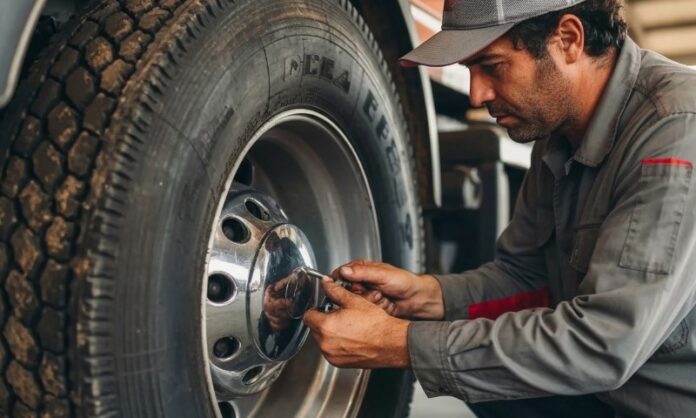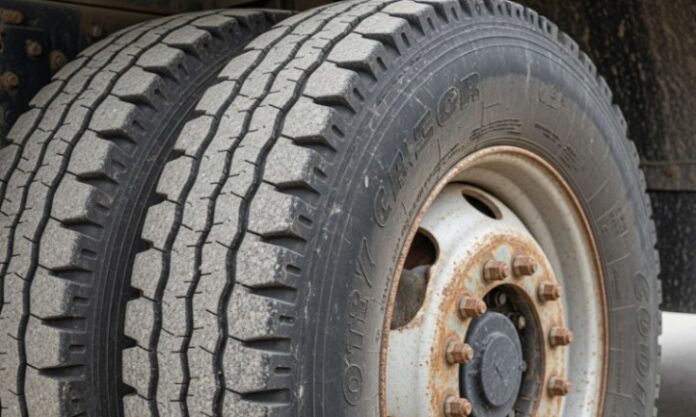Highway truck tires quietly carry an entire operation. They take on extreme loads, temperature swings, curbing, and long stretches of asphalt without complaint.
Yet, for all that endurance, their lifespan depends less on luck and more on discipline: consistent inflation checks, smart alignment habits, careful matching, and a plan for retreading.
Extending tire life is a maintenance mindset that pays back in uptime, safety, and lower cost per mile.
Below is a practical, real-world playbook that fleet managers and owner-operators can apply starting today.
Key Takeaways
- Tire life depends on consistent habits, not one-time fixes.
- Proper inflation, alignment, and matching save both tread and fuel.
- Smart automation (ATIS/TPMS) shortens underinflation time.
- Protect casings early to unlock retread value.
- Driving technique matters as much as maintenance discipline.
Why Tire Life Is Won or Lost in Daily Habits
Every tire’s story begins with pressure and ends with casing condition. A tire that runs underinflated builds heat, weakens its structure, and sheds tread unevenly.
One that’s overinflated loses its footprint, rides rough, and wears the center faster than the shoulders. And when duals, alignment, or suspension aren’t right, irregular wear patterns start carving away value long before a blowout.
It’s also a regulatory issue. The Federal Motor Carrier Safety Administration (FMCSA) treats tire condition as a critical safety factor, as it can lead to accidents. Minimum tread depths are defined in 49 CFR §393.75 – 4/32 inch on steer tires, 2/32 inch on other positions. Violations can take a vehicle out of service on the spot.
Then there’s fuel. Tires account for roughly 30 percent of a truck’s fuel consumption according to major tire makers and fleet studies.
The EPA SmartWay program reports that verified low rolling resistance (LRR) tires can deliver up to 3 percent fuel savings when installed across all axle positions and kept properly inflated. Retreads verified under SmartWay can perform just as well.
What the Science and Rules Say
Improper inflation is the single fastest way to shorten a tire’s life. It increases internal stress, raises running temperature, and can lead to structural separations or rapid wear.
- FMCSA guidance : Drivers should check tire pressures cold before every trip and inspect for cuts, bulges, and other visible issues.
- TMC RP 235 (Technology & Maintenance Council Recommended Practice): Explains that tire pressure naturally fluctuates with temperature and service conditions, which means fleets need a program, not just spot checks.
Even a 10 psi deviation can shift load distribution, increase rolling resistance, and cut thousands of miles from the tread.
Reliable equipment helps too. Hubtrac tires for trucks from Austria are built with high structural integrity to handle these demands day after day.
Practical Steps That Extend Life

- Gauge cold, not hot. Tire pressure rises during operation by about 10 to 15 percent. Set pressures using cold readings before the truck moves.
- Calibrate gauges regularly. A few psi of inaccuracy across a fleet adds up to real cost.
- Set axle-specific targets. Use the manufacturer’s load and inflation tables for your exact tire size and configuration.
- Define “flat” correctly. Most trainers consider a tire below 80 percent of target pressure flat and unsafe for reinflation.
- Use commercial-grade valve hardware. Valve cores and caps are cheap insurance against leaks.
Automation That Pays Off
Automatic Tire Inflation Systems (ATIS) and Tire Pressure Monitoring Systems (TPMS) have become proven technologies, not luxuries.
- U.S. DOT studies found drive tire life improved by around 19 percent in fleets using TPMS or ATIS.
- EPA SmartWay data notes up to 1.2 percent fuel economy improvement from consistent inflation management.
They don’t replace daily checks, but they dramatically shorten the time a tire spends in an underinflated state.
Match Duals Like Your Tire Budget Depends on It

Dual assemblies must work as a pair. If one tire is larger, the smaller one scrubs to keep up, overheating and wearing out early. That mismatch also destroys casing integrity, killing retread potential.
Key Targets to Follow
| Metric | Recommended Tolerance | Why It Matters |
| Diameter difference | Within ¼ inch | Prevents load shift and uneven wear |
| Tread depth difference | Within 4/32 inch | Keeps rolling circumference aligned |
| Pressure difference | Within 5 psi | Equalizes load between duals |
Even small differences add up over hundreds of thousands of rotations. If the diameter or tread depth can’t be matched by brand and model, measure the rolling circumference and pair accordingly.
When ignored, the larger tire carries a heavier load, sometimes hundreds of pounds more, while the smaller tire scrubs itself bald trying to keep pace.
Read the Rubber and Act Early

Alignment is one of the quietest tire killers on the highway. It rarely causes sudden failure, but it steadily erases tread life.
Alignment Intervals That Work
According to TMC RP 642 , alignment should be checked:
- After break-in at 15,000–30,000 miles
- Every 80,000–100,000 miles afterward
- Or at least once per year , whichever comes first
Also check alignment after curb strikes or suspension work.
Common Wear Patterns and What They Mean
| Pattern | Likely Cause | Fix |
| Feathered ribs | Toe misalignment or worn steering parts | Adjust toe, inspect components |
| Diagonal/cupped patches | Runout, imbalance, or worn shocks | Correct balance, replace shocks |
| Center wear | Overinflation or light load | Reduce pressure to correct range |
| Shoulder wear | Underinflation or excessive camber | Adjust inflation or suspension |
Add a quick tread-depth map at each preventive maintenance (PM) interval. Measuring rib-by-rib helps detect trends before they cost a casing.
Rotation and Position Strategy for Long-Haul
Even steady highway duty causes irregular wear over time. A rotation plan can equalize patterns and extend mileage before the first retread.
Guidelines by Position
- Steer tires: If shoulder or diagonal wear appears early, rotate side to side (if the manufacturer approves). Check toe and balance after each swap.
- Drive tires: Keep similar tread designs together. Mixing aggressive traction with low-void LRR designs creates heat and irregular wear.
- Trailer tires: Often overlooked but critical. Rotate based on mileage or when tread variance exceeds your preset limit (commonly 4/32 inch).
Always verify rotation practices in your tire maker’s manual. Some patterns are directional, and improper rotation can accelerate wear.
Protect the Casing, Retread for Profit
@thetire.girl Building some drive retreads. 👊🏻#retread #truckertok #semi #thetiregirl #michigan #dptireservice #foryoupage #tire #friday
The casing is the tire’s backbone and a major financial asset. Properly maintained, it can live multiple lives through retreading.
How to Keep Casings Retreadable
- Maintain pressure and prevent heat buildup. Most failed retreads trace back to chronic underinflation or overloading.
- Track each casing. Use an ID system to record mileage, position, and pull reason.
- Clean removals. Remove stones, check for sidewall cuts, and send casings for inspection promptly.
Major brands design premium casings for multiple retreads. When treated correctly, retreaded drive or trailer tires can rival new tire mileage at about half the cost.
Choose Low Rolling Resistance Wisely, and Run It Correctly
Fuel efficiency is part of tire life economics. Low rolling resistance (LRR) tires lower fuel use when the entire system, tractor, trailer, and retreads, is managed together.
What the Program Requires
EPA SmartWay verification applies to specific tires and retreads. Verified LRR tires and retread technologies must be installed on designated axle positions to achieve the promised savings.
What to Expect
- Around 3 percent fuel savings when verified tires are used on all positions and properly maintained.
- Even higher gains possible with single-wide configurations in long-haul duty cycles.
But LRR gains disappear if inflation, alignment, or matching are neglected. The best tire design cannot overcome poor maintenance habits.
Comply with Tread Depths and Inspect Like You Mean It
Federal rules are clear:
- 4/32 inch minimum tread depth on steer tires
- 2/32 inch minimum on all others
Measure across multiple grooves, not just one spot. Document findings in your inspection log.
FMCSA also advises daily checks for bulges, cuts, or irregular wear. Spotting a stone drill or belt exposure in the yard can prevent a roadside blowout that costs hours and money.
EU and International Context for Long-Haul Fleets

Fleets operating in Europe or crossing borders must stay aware of additional standards that impact tire life and compliance.
UN ECE Regulation No. 54
Covers commercial vehicle tires in categories M2, M3, N, O3, and O4 . It defines load indexes, speed symbols, and service descriptions. Keeping tires within their approved service description protects both performance and legal compliance.
EU Tyre Label Regulation 2020/740
Truck and bus tires are labeled for:
- Rolling resistance (fuel efficiency)
- Wet grip (safety)
- External noise (environmental compliance)
Each tire carries a QR code and class ratings from A to E. Better grades in rolling resistance or wet grip can make real operational differences, especially for high-mileage fleets.
Storage, Handling, and Mounting That Preserve Life
Tire care doesn’t stop once they’re off the truck. How they’re stored and mounted matters too.
Best Practices
- Store in a cool, dry, dark place. Heat and sunlight accelerate rubber aging.
- Keep away from ozone sources. Electric motors and welders can damage compounds over time.
- Use correct rim width and spacing. Wrong spacing can cause sidewall contact and heat buildup.
- Follow manufacturer safety procedures. Use safety cages and remote inflation devices when mounting or inflating.
Driver Habits That Make or Break Mileage
https://www.youtube.com/watch?v=mpyTqptxvnw
Even the best equipment can’t overcome bad driving habits. A disciplined driver is often the cheapest tire protection a fleet can buy.
Smart Habits That Extend Tire Life
- Control speed. High speeds generate more heat, reducing tread life.
- Take wider turns. Tight pivots cause scrub and shoulder wear.
- Avoid curbing. Steer shoulder cuts from curbs are among the most common casing-killers.
- Plan pull-throughs. Keep axles rolling to reduce lateral stress.
Driver education programs consistently show measurable tire-life improvements when operators follow these habits.
Quick-Look Maintenance Table
| Task | What to Do | Interval |
| Pressure check | Gauge cold, adjust to load table targets | Daily pre-trip; every fuel stop on long runs |
| Dual match | Verify tread depth and diameter; keep within 4/32 and ¼ inch | At mounting; at each PM |
| Alignment | Check at 15k–30k miles post-break-in; then 80k–100k miles or 12–18 months | Regularly or after component work |
| Tread mapping | Measure multiple ribs and note patterns | Each PM |
| ATIS/TPMS | Inspect fittings and alerts | Each PM; review data monthly |
| Casing care | Clean, inspect, tag for retread | At pull; retread if casing passes |
Putting It All Together
The fleets that get the longest life from their highway tires aren’t doing anything secret. They just do the basics well, every single day.
They standardize gauge calibration, valve caps, and inflation targets. They use ATIS and TPMS not to skip checks, but to reduce underinflation time.
They schedule alignments before tires start pulling and track tread patterns to spot trouble early. They pair duals precisely and log casings like assets, not expendables.
When those small steps add up, tires run cooler, casings stay stronger, and retreads deliver full value. The result is predictable performance, safer highways, and healthier profit margins.







